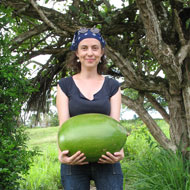In the News: Dr. Ina Vandebroek Talks about Immigrants, Medicinal Plants, and Health Care
Posted in Interesting Plant Stories, Videos and Lectures on October 20, 2014 by Ina Vandebroek
Ina Vandebroek, Ph.D., is an ethnomedical research specialist at The New York Botanical Garden’s Institute of Economic Botany. One of her research interests is studying how immigrant populations in New York City use traditional plant-based remedies in their health care.

En Tu Comunidad is a public affairs program on the Spanish-language network Unimas that serves the New York City metropolitan area. The show is hosted by Enrique Teuteló.
Enrique invited me on the show to talk about my research in ethnomedicine—specifically, the use of medicinal plants in Latino and Caribbean communities in New York City, especially within the community from the Dominican Republic—and how this research can help physicians establish a better relationship with their Spanish-speaking patients.
Read on for a short English summary of our conversation, plus the full video of the interview in Spanish.
Enrique: How did you get into this intense work in ethnomedicine, or shall I call it “green medicine”? Tell us.
Ina: Ethnomedicine is the science that studies the relationship between cultures (people) and medicinal plants (or home remedies) for self-medication. I studied biology, and after that I was fascinated by green medicine, by plants, and that is why I went to Bolivia.
Enrique: Why did you choose Bolivia? Because of the indigenous cultures that have a close relationship with plants?
Ina: Bolivia is a country where cultural traditions are still very strong and the people still use a lot of medicinal plants. This is true in many countries, not only in Bolivia, but I began my research in ethnomedicine in Bolivia.
Enrique: The medical community is getting more and more interested in this topic of medicinal plants. This is funny because not too long ago, when one spoke about home remedies, it was seen as something backwards, obscure. How did this union between scientific medicine (or biomedicine) and traditional medicine start to form? Today, is there still a separation between both types of medicine, or are they perfectly united?
Ina: There still exists a separation. But physicians are increasingly becoming aware that people continue to use their home remedies because those remedies are a part of their culture. People have faith and confidence in their herbal medicines. It happens that physicians give a prescription to their patients, but they may ignore this and go to a botánica store instead to buy plants that are part of their culture.
Enrique: Is this type of alternative medicine, if I may call it that, used as a complement to mainstream medicine, to biomedicine? How do people decide which kind of medicine they want to use?
Ina: People may choose several things. We did interviews with 175 people from the Dominican Republic who live in New York City. People sometimes would tell us, “I take my herbal teas together with pharmaceuticals, that way I get cured twice as fast.” Someone else would say, “I get tired of taking so many pills; they give me a stomach ache. That is why I drink my herbal teas.”
Enrique: You are offering courses to the medical community so that physicians can familiarize themselves with the topic of medicinal plant use, to make sure this is something that is not overlooked.
Ina: Patients are sometimes scared to talk to their physician about their use of medicinal plants, and they should not be because it is part of their culture, of their traditions. With our training program for physicians, we try to help develop a better dialogue between patient and physician, so that there is more trust and less fear from patients to talk about their herbal remedies.
Enrique: Part of your large study has identified ten illnesses that affect the Dominican community a lot, and for which herbal remedies play an important role in their treatment, such as flu, diabetes, hypertension, cholesterol…
Ina: This shows that ethnomedicine is not something from the past. People use plants to treat modern illnesses, chronic illnesses, illnesses that they suffer here, in New York City.
Enrique: How about the other cultural part, things that can not be cured by physicians nor by herbs, such as culebrilla (herpes zoster), asthma, witchcraft, disipela, cancer, the evil eye, empacho. How can this be related to what you are doing?
Ina: Through our research we try to understand what these health problems are, according to the community. What are the symptoms, perceived causes, and preferred treatments? We bring this information to physicians so that they can improve the dialogue with their patients about these conditions.
Enrique: Interesting! Our community can consult the website of The New York Botanical Garden to learn more about your studies.

